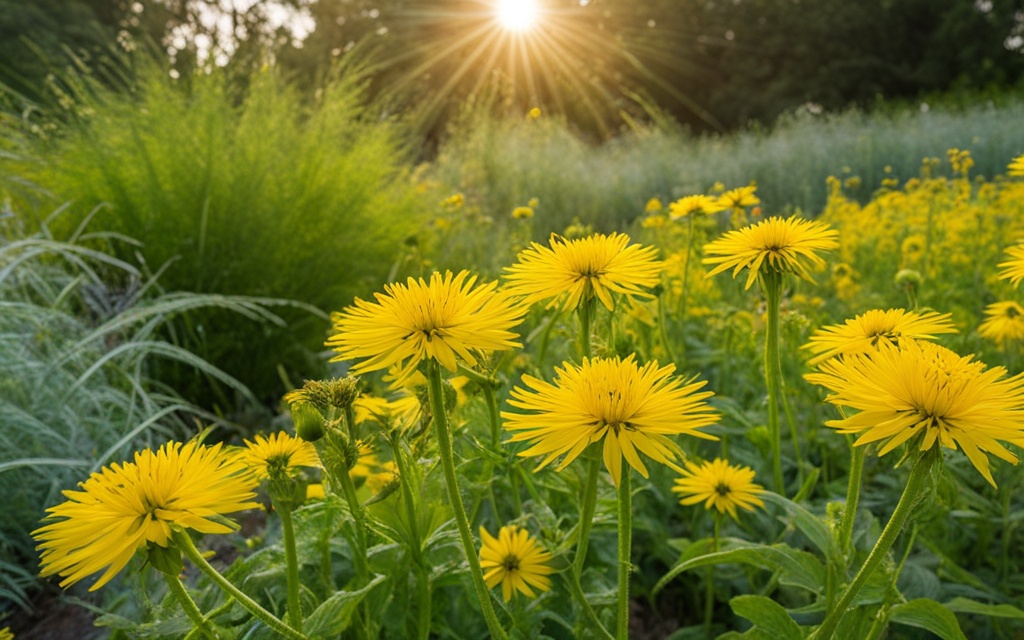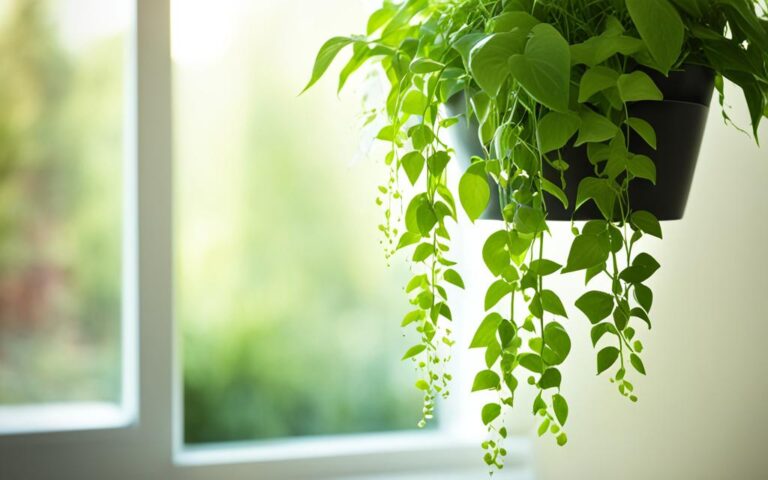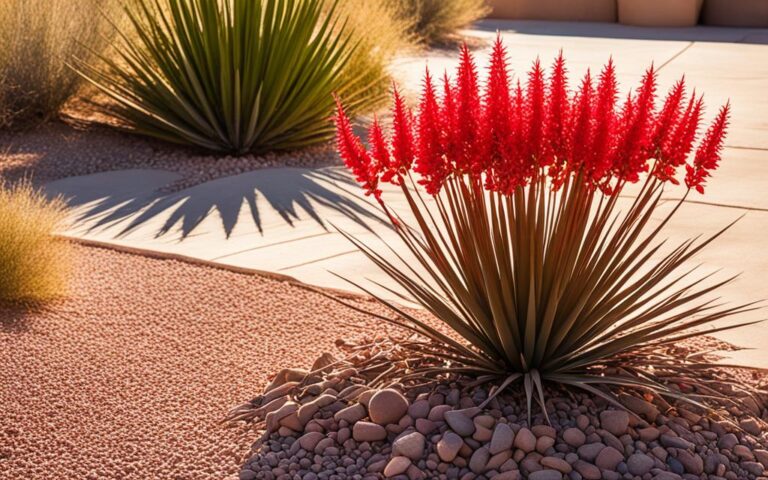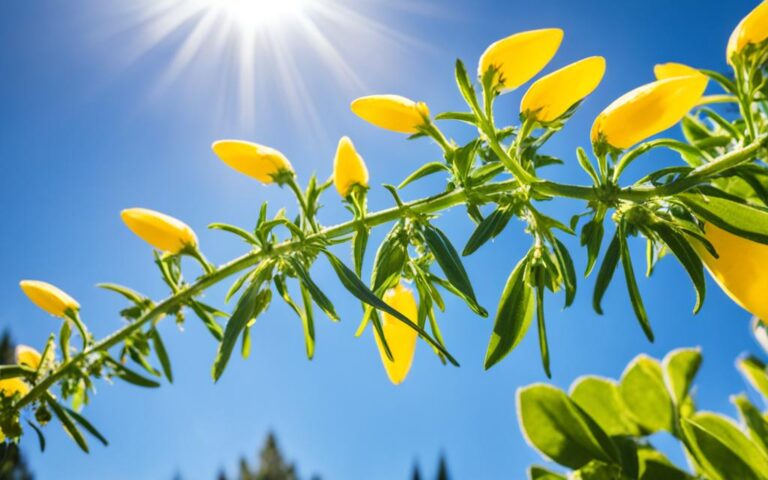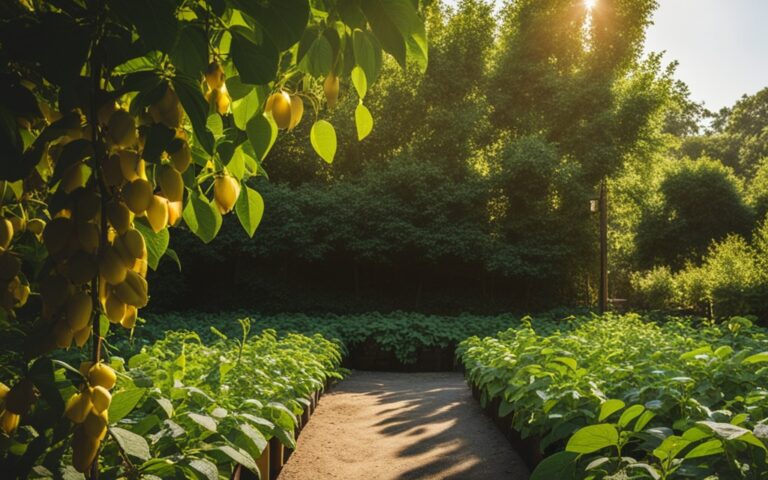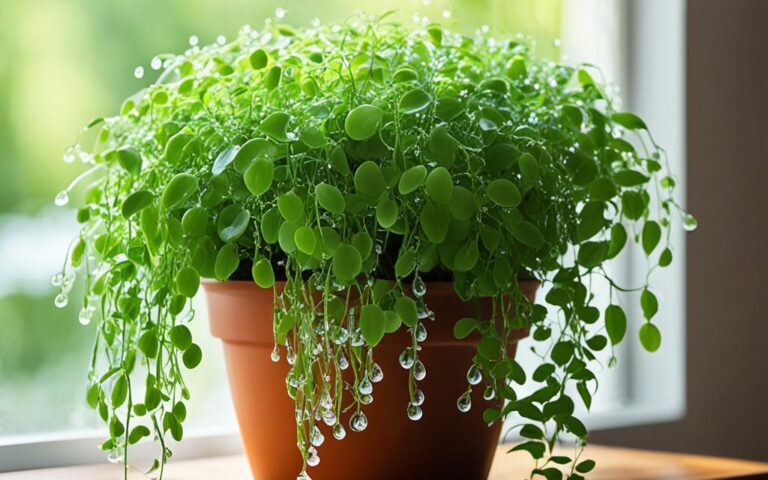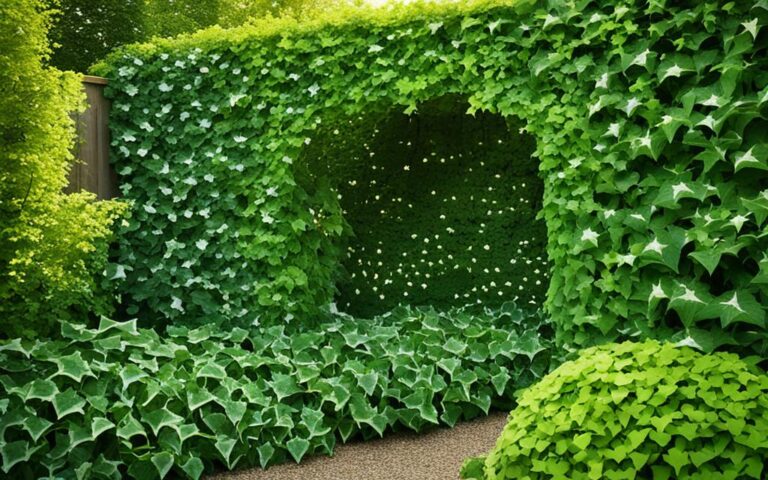Cup Plant: Unique Native Wildflower for Gardens
The Cup Plant (Silphium perfoliatum) stands tall at up to 8 feet, catching the eye in any garden. It’s a native perennial known for its bright, golden-yellow flowers and special leaves. These leaves form a cup around the stem, drawing in birds, pollinators, and wildlife.
This plant is easy to care for and can handle drought. It’s perfect for gardens in various settings, from open prairies to the edges of woods.
Key Takeaways
- Cup Plant (Silphium perfoliatum) is a tall, native perennial wildflower with striking yellow flowers
- The plant’s distinctive cup-like leaf structures attract birds and provide water sources
- Cup Plant is drought-tolerant and deer-resistant, making it a low-maintenance garden addition
- The nectar-rich flowers attract a variety of pollinators, including butterflies, hummingbirds, and bees
- Cup Plant is found in various regions across the central and southern United States and Canada
Introduction to the Remarkable Cup Plant
The cup plant, a captivating native wildflower, is becoming more popular in gardens across the U.S. It grows tall, up to 8 feet, and has bright yellow flowers that draw in many pollinators.
This plant is known for its special leaves that form cups to hold rainwater and dew. This feature not only looks interesting but also helps local wildlife. It’s easy to care for and grows well in many places, making it a great choice for native garden plants.
If you’re new to gardening or experienced, the cup plant is a great addition. Its tall stature and colorful flowers will catch your eye. Plus, it helps your garden attract wildlife, making it healthier and more diverse.
“The cup plant is a true marvel of nature, blending form and function in a way that inspires awe and wonder in all who encounter it.”
Next, we’ll explore why the cup plant is a great choice for gardeners and nature lovers. Get ready to be amazed by this beautiful native wildflower.
What is a Cup Plant?
The cup plant, known as Silphium perfoliatum, is a special herb in the Asteraceae family. It can grow up to 10 feet tall. Its leaves are big and have teeth, and they join together around the stem, forming a “cup” that holds water. This is why it’s also called “Indian Cup” or “Cup Plant.”
Botanical Profile and Interesting Facts
This plant is from eastern and central North America. You can find it in places like Alabama, Georgia, Illinois, and New York. It’s also in Canadian provinces such as Ontario and Quebec. In Michigan, it’s considered threatened, but in New York, it’s banned because it’s invasive.
It has a deep root system, which helps it live up to 50 years. It spreads through roots and shallow underground stems. Each flower head has 20 to 30 seeds, which are shaped for the wind to carry them away. The plant is seen as a possible source of energy, producing a lot of biomass and dry weight each year.
Common Species and Varieties
There’s a main type of cup plant, Silphium perfoliatum, but there are others too. Each has its own look. Here are a few:
- Silphium integrifolium (Rosin Weed): This variety has leaves that are not split up.
- Silphium trifoliatum (Whorled Rosinweed): Its leaves grow in circles and are long and thin.
- Silphium laciniatum (Compass Plant): Its leaves are deeply cut and look like a compass, always facing north-south.
These different types of cup plants give gardeners and landscapers many choices. Each one has its own special look and charm.
Anatomy of the Cup Plant
The cup plant (Silphium perfoliatum) is a wildflower that stands out with its unique look. It has sturdy stems that can reach up to 10 feet tall. These stems support large leaves that are fused together to form a “cup” around the stem. This special design can hold water, drawing in birds and other animals.
The cup plant flowers are just as eye-catching, with big, yellow blooms that have 20-30 ray petals and darker yellow centers. These flowers bloom in the summer, making any garden look brighter. The stems of the plant support these beautiful flowers well.
Special Features: The Unique “Cup” Formation
The cup plant’s most notable feature is its “cup” or “basin” shape. This comes from the leaves that join together around the stem. It acts as a bird bath, collecting rainwater for animals. The leaves also help direct water to the roots, keeping the plant moist in dry times.
Ideal Growing Conditions for Cup Plants
Cup plants (Silphium perfoliatum) need certain conditions to thrive. They love full sun to partial shade and prefer moist, well-draining soils. They can grow in many soil types, from dry to wet, and even clay soils. These plants are hardy in USDA zones 4 through 8, handling different temperatures and humidity levels.
Light, Temperature, and Humidity Requirements
Cup plants do best with 6-8 hours of direct sunlight daily. They can handle some shade, but less sun can make them tall and reduce flowers. These plants like a wide temperature range and can handle various humidity levels.
Soil Preferences and Watering Needs
- Soil: Cup plants like moist, well-draining soils but can also grow in clay or dry soils.
- Watering: They need consistent moisture, especially when growing. But, they can survive with less water once they’re established.
Having the right soil and watering is key for cup plants to flourish. By giving them the best environment, gardeners can enjoy their beautiful blooms and unique leaves. These plants are hardy and easy to care for.
Propagating Cup Plants
Growing the cup plant (Silphium perfoliatum) is rewarding for gardeners. It’s known for its unique leaves and bright yellow flowers. You can easily spread it through seeds or dividing the plants.
Cup Plant Seed Propagation: Plant cup plant seeds in the fall for best results. They need cold weather to wake up. Or, plant them in spring after 12 weeks of cold.
Put the seeds 1/4 to 1/2 inch deep in the soil. Keep the soil moist until they grow, which takes 2-4 weeks.
Cup Plant Division: Dividing the plant is tricky because of its deep roots. But, you can do it in spring or fall. Make sure each piece has roots and plant it at the same depth as before.
For easy gardening, use cup plant seeds or nursery plants. With the right methods, you can enjoy its beauty and benefits in your garden.
Caring for Your Cup Plant Garden
Looking after a cup plant garden is easy. This native wildflower is tough and doesn’t need much work. But, you might need to trim it to keep it the right size. Cutting off dead flowers can also make it bloom more.
Cup plants are usually safe from pests and diseases. But, watch out for powdery mildew or bugs that eat leaves. You can use natural ways or special treatments to fix these problems.
Pruning and Training Techniques
Cup plants can grow 4 to 8 feet tall. So, you might need to prune them to keep them nice-looking. The best time to cut them back is in late spring or early summer, before they get too big.
- Deadhead spent flower heads to encourage continued blooming.
- Trim back overly tall or leggy stems by a third to maintain a compact, bushy habit.
- Use clean, sharp pruners to make precise cuts just above a set of leaves or side branches.
Pests, Diseases, and Recommended Treatments
Cup plants are pretty tough, but they can get pests and diseases sometimes. Keep an eye on your plants and fix problems fast to keep them healthy.
| Issue | Symptoms | Treatment |
|---|---|---|
| Powdery Mildew | White, powdery growth on leaves and stems | Apply a baking soda or neem oil-based fungicide |
| Leaf-feeding Insects | Holes, discoloration, or wilting leaves | Use insecticidal soap or introduce beneficial insects |
By following these easy cup plant care tips, you can have a beautiful cup plant garden. It will attract bees and butterflies and make your outdoor area look great.
Benefits of Growing Cup Plants
Gardeners looking for a low-care, wildlife-friendly plant should think about adding cup plants (Silphium perfoliatum) to their gardens. These tall native wildflowers bring many benefits. They are perfect for both pretty gardens and helping the environment.
Attracting Pollinators and Wildlife
Cup plants draw in hummingbirds, butterflies, and bees. Their flowers are full of nectar, which is great for these important animals. The leaves also collect rainwater, offering a cool drink to birds, frogs, and other creatures.
Low Maintenance and Deer Resistance
Cup plants are easy to care for. They can grow up to 12 feet tall and spread out a lot, needing little attention. Plus, they keep deer away, which is great for gardens with deer problems.
Adding cup plants to your garden makes it a lively spot that’s easy to keep up. They help bring in pollinators and offer a place for animals to get water. These plants are a big help to gardeners and the environment.
| Benefit | Details |
|---|---|
| Pollinator Attraction | Cup plants attract a diverse array of pollinators, including hummingbirds, butterflies, and bees, thanks to their nectar-rich flowers. |
| Water Source for Wildlife | The cup-like leaves of the cup plant collect and hold rainwater, providing a vital water source for birds, frogs, and other animals. |
| Low Maintenance | Cup plants are hardy, drought-tolerant perennials that require minimal care, making them a low-maintenance addition to the garden. |
| Deer Resistance | Cup plants are generally unpalatable to deer, ensuring your garden remains protected from these herbivores. |
“Cup plants are a true asset to any wildlife-friendly garden, attracting a diverse array of pollinators and providing a reliable water source for birds and other animals.”
Cup Plant in Native Habitats
The cup plant (Silphium perfoliatum) thrives in moist woods, prairies, and low-lying areas in eastern and central North America. It stretches from southern Ontario to North Carolina and west to the Great Plains. It loves the wet to mesic soil of these areas.
This wildflower is a true native of the Midwest and South. Early European settlers and Native American communities knew it well. These plants grow 3-10 feet tall, showing off their cup-shaped leaves and lots of flowers from July to October.
In its natural habitats, cup plants form dense colonies. These colonies are great for wildlife. Pollinators like bees, butterflies, and hummingbirds visit the flowers for nectar. Songbirds eat the plant’s seeds.
Keeping the cup plant’s native habitats safe is key to its survival. This means taking care of riparian systems and healthy floodplain forests. By learning about the plant’s role in nature, we can help protect it. This way, we keep the Midwest and South’s landscapes diverse.
“The cup plant is a true icon of the Midwest, thriving in the region’s rich wetlands and prairies for centuries. Its historical significance and ecological value make it a cherished native species worth preserving.”
Incorporating Cup Plants into Your Garden Design
Cup plants stand tall with their bold, yellow flowers. They fit well in many garden styles, from natural prairies to formal borders. These native wildflowers bring height and interest to your garden.
Group cup plants together for a stunning focal point. Or, place them to match other plants and pollinators. Their tall stems and unique leaves are perfect as a backdrop or accent.
For a beautiful cup plant garden design, consider these tips:
- Use cup plants as a bold, structural element in your garden, leveraging their height and presence to anchor the design.
- Pair cup plants with complementary native species, such as prairie grasses, coneflowers, and butterfly-attracting plants, to create a harmonious and naturalistic look.
- Explore cup plant landscaping options that highlight their unique cup-shaped leaves, using them as a focal point or to define pathways and borders.
- Strategically place cup plants in your garden to create depth, rhythm, and visual interest, allowing their towering presence to draw the eye and add drama to the overall design.
Thoughtfully adding cup plants to your garden makes a stunning, nature-inspired landscape. It celebrates the beauty and biodiversity of these remarkable native wildflowers.
“The key to successful gardening with native plants like cup plants is to understand their specific needs and design a landscape that caters to their unique characteristics.”
Adding cup plants to your garden is about more than looks. It supports local ecosystems and helps pollinators and wildlife. These versatile and resilient plants make your garden both beautiful and good for the environment.
Where to Find Cup Plant Seeds and Plants
Gardeners looking to add the cup plant to their gardens have many options. They can find cup plant seeds and seedlings at native plant nurseries, both local and online. These nurseries sell plants that fit the specific needs of different regions.
Groups like the Native Seed Network and native plant societies also offer seed exchanges and sales. This makes it easy for gardeners to get cup plant seeds and plants. By buying from these places, gardeners know they’re getting plants that will do well in their gardens.
For those wanting to grow cup plants from seed, remember that the seeds need cold to wake up. Many sellers give clear instructions on how to plant and care for the seeds. This helps ensure the cup plants grow well.
When buying cup plant plants, choose healthy ones from well-known nurseries. These plants are easier to move to your garden than ones picked in the wild. They usually grow better too.
Getting cup plant seeds and plants from reliable sources lets gardeners add this special wildflower to their spaces. They’ll enjoy its unique leaves, beautiful flowers, and the good it does for the environment.
The Fascinating History and Folklore of the Cup Plant
The cup plant, also known as “Indian Cup” or “Rosin-weed,” has a rich history. It’s especially important to Native American tribes. Its leaves look like cups, perfect for catching rainwater. This earned it the name “cup plant.”
Native Americans used the plant’s sticky sap in many ways. They chewed it as gum and used it to seal things.
The plant’s bright yellow flowers and tall height made it stand out. It was used in traditional medicine to help with many health issues. This included problems with the lungs and skin.
The cup plant is tied to the traditions of many Native American tribes. In some, it was seen as spiritual. The leaves were used in rituals and ceremonies. Its unique look and uses made it a part of folklore and legends.
Scientists are also interested in the cup plant. They study its unique features, chemicals, and possible health benefits. This research helps us learn more about this amazing wildflower.
“The cup plant’s cup-like leaves were a source of wonder and inspiration, serving as a testament to the ingenuity and resourcefulness of the indigenous people who called this plant their own.”
The cup plant’s story shows how deeply connected humans are to nature. Its history and folklore highlight our bond with the earth. By studying this plant, we learn about the rich culture that has lasted for centuries.
Conclusion
The cup plant is a standout native wildflower that should be in every garden in the U.S. It has bright yellow flowers and leaves shaped like cups. It’s great for pollinators and wildlife, and it’s easy to care for. The cup plant is perfect for those who want to add beauty and help nature to their gardens.
Adding cup plants to your garden helps local ecosystems and brings many benefits. They grow well in open areas and near homes, especially in warm spots. This makes them a great choice for gardeners looking to support nature.
The cup plant is also being considered for biomass energy in Europe. It can produce a lot of biomass and has lots of honey and pollen. By growing this plant, gardeners can make their gardens more diverse and beautiful. They also help the environment.
